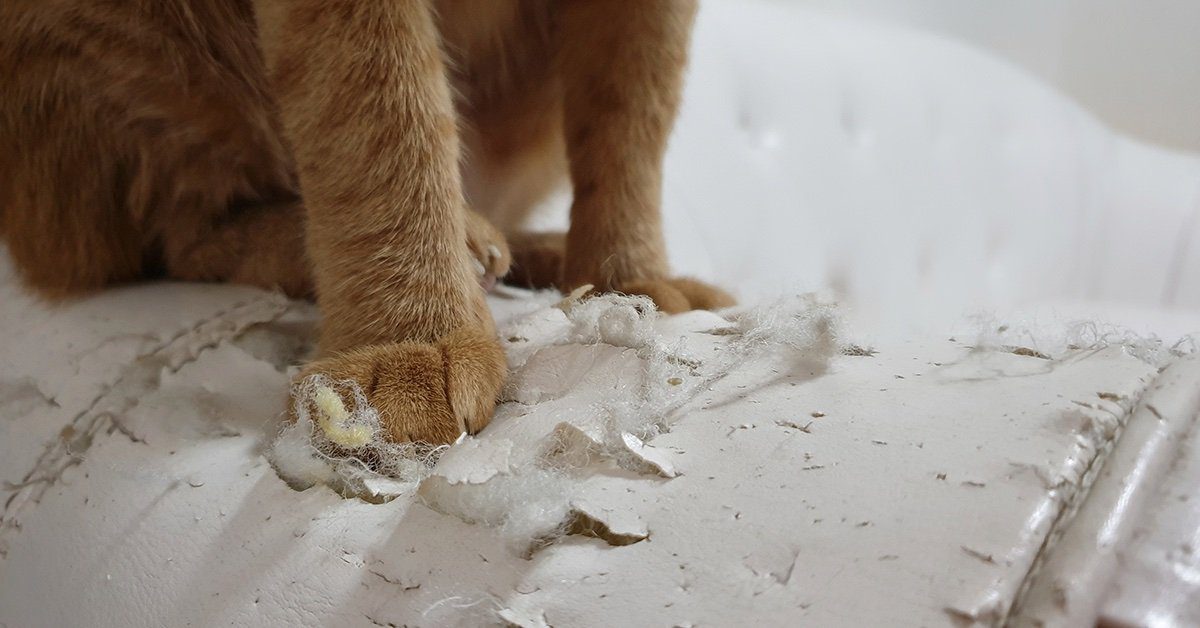Just like humans, cats experience fear, pleasure, anxiety, frustration, and many other emotions that can affect their behavior. While some cat behaviors are normal, others are not, and can indicate a behavioral problem or health issue.
Here, we’ll discuss the most common behavioral problems in cats, how you can correct many of these behaviors, and when you should seek out professional help.
What causes behavioral problems in cats?
Cats are funny animals, each with their own unique personality. Discovering the cause of their behavior changes can be a challenge, as they can happen for a multitude of reasons. One minute, your cat could be rubbing against your leg and purring, and the next they could be scratching you and yowling at 3 AM. Although this behavior can be frustrating, it’s best to seek to understand it. Too often, adult cats are abandoned or surrendered to shelters due to feline behavior issues. Rather than giving up, it’s best to seek help. Let’s dive into some common behavioral problems in cats and what they might mean.
What are the most common behavioral problems in cats?
From rejecting the litter box to scratching up your furniture, cats can display many frustrating behaviors. However, some cats (especially kittens) don’t know the difference between acceptable and unacceptable behavior. The good news is that you’re not alone. In fact, 77% of pet parents have experienced a behavior problem with their cats. The most common behavioral problems in cats include:
1. Scratching
Furniture scratching is one of the most common behavioral concerns, as cats scratch to mark their territory. Almost 84% of cats scratch inappropriate household items, including chairs, carpets, and other furniture. While this behavior isn’t abnormal, it can increase the likelihood of your cat becoming worried about their territory. If you rearrange the house or throw away a scratched up piece of furniture, they might act out.
2. Chewing
While cats aren’t as voracious as dogs, they can still manage to cause a good bit of damage with their teeth. Excessive chewing may be caused by boredom or aggression, or perhaps because your cat is playing and enjoys the texture and taste of what they’re chewing. In kittens, chewing behavior may signify teething or that they were weaned too young.
3. Urine Marking
Inappropriate elimination, or inappropriate urination, is the most common behavior problem reported by pet parents. It’s estimated that 10% of cats will eliminate outside their litter box at some point in their lives, whether it be caused by infections, inflammation, bladder stones, stress, or tumors. Conflicts between cats or other pets in the house can stress cats and lead to litter box issues. If your kitten is still in their litter training phase, this can also be the cause of urine marking.
4. Aggression
Cats may become aggressive towards other pets and people, or even their owners, for a number of reasons. This behavior can be caused by stress and anxiety, or by a medical problem that causes pain or hormonal changes in your cat. If your cat is afraid, this type of aggression is usually accompanied by warning signs, such as hissing and crouching. Sometimes your cat is simply playing, and may attack if they’re overstimulated and fail to understand what behavior is acceptable. Fixing this problem requires better understanding of what exactly is causing this behavior, and is best approached by a veterinarian and animal behaviorist.
5. Obsessive-Compulsive Licking
All cats lick themselves, but chronic licking typically stems from pain, stress, or anxiety. Excessive licking may be serious, and a sign that your cat is in pain. They may lick an area of their body until it’s hairless and raw, or obsessively groom other parts of their body.
6. Vocalization
Cats are vocal creatures, and it’s common for cats to meow to let you know they’re hungry or want to play. It’s typically normal to hear your cat howling and crying at the top of their lungs outside your bedroom door at night, considering cats tend to be more active when their owners go to bed. They may be bored, hungry, or simply want your attention. Siamese cats are naturally more vocal than other cat breeds, and may meow loudly to demand your attention. However, howling can be a sign of senility in older cats, and daytime meows could be a sign that your cat’s in pain.
How to stop cat behavior problems
If your cat’s personality or behavior suddenly changes, a trip to the vet to make sure they aren’t sick or in pain is the best way to get to the bottom of their behavior. Your vet can discuss supplements, medications, pheromones, special diets, and other things to help curb your cat’s behavioral issues. After that, you can start to discourage your cat’s behaviors, and help them overcome whatever is causing them to act out. Here are some proven ways to address your cat’s undesirable behavior.
- Unwanted scratching can be addressed by providing your cat with scratching posts or cat condos that they can dig their claws into, so that they stay away from scratching furniture. Some cats like certain fabrics and materials more than others, so you may need to try scratching posts that offer various textures. Be sure to place them in different areas around the house; it’s helpful to place them on vertical surfaces and perches so that your furry friend gets hours of play. You can also use pheromones to help calm your cat and discourage any scratching behavior that may be caused by stress and anxiety. Pheromones are available in sprays, wipes, and diffusers.
- If your cat has a chewing problem, the first step is to check with your vet to eliminate any dental problems. If you rule this out, it’s possible that your cat is taking their pent-up aggression out on the object they’re chewing, and pheromones and supplements may help decrease this aggressive behavior.
- Litter box problems need to be addressed immediately by a veterinarian. Special litter, diets, pheromones, supplements, and medications can help with urinary behavioral problems in your cat. When medical conditions have been ruled out, the cause for their inappropriate elimination is usually harmless. If you suspect that they don’t like the type of litter you’re using, try switching to an unscented litter or a different brand, and make sure their litter box is consistently clean. If you have multiple cats, make sure each one has their own litter box, and that the boxes aren’t close to each other. Just like humans, cats want their privacy when using the bathroom.
- If your cat is attacking you, or demonstrating other aggressive behaviors, don’t punish them. This only makes the problem worse, so it’s best to ignore them entirely, as reacting or running away may make the game more exciting for them. Again, pheromones, supplements, medications, and special diets may help curb this unwanted behavior. You can also give your cat other things to focus their energy on, like exercise-inducing toys or catnip. Be sure to rotate them regularly to keep things fresh!
- Excessive licking likely needs a vet or qualified behaviorist’s input, so a good first step is to speak with your veterinarian. In the meantime, you can work on making your cat’s environment feel more safe and secure to reduce their stress and anxiety. Try building them a safe space where they can go without being disturbed, or adding pheromones to make them feel secure.
- If your furry friend is howling or crying at the top of their lungs at night, try to provide them with more exercise during the day so they’re less active at night. They may be hungry, want to go outside, or be seeking attention, so be mindful of your response. If you jump to them each time they demand your attention, you will train your cat to continue to make these vocalizations to get what they want.
Kittens are better able than adult cats to adapt to environmental changes, so be sure to expose them to a lot of different experiences when they’re young. If you expose your kitten to anything and everything they may come into contact with as an adult, you’re much less likely to end up with a fearful cat. By enriching your furry friend’s life, they’re also less likely to end up bored, which can help prevent cat behavior issues.
Remember, it’s better to prevent behavioral problems than wait to treat them, so the earlier you can socialize your furry friend, the better. However, sometimes no matter what we do, behavioral issues do arise, which is why Pumpkin’s cat insurance plans can help you pay for covered treatments and therapies.




